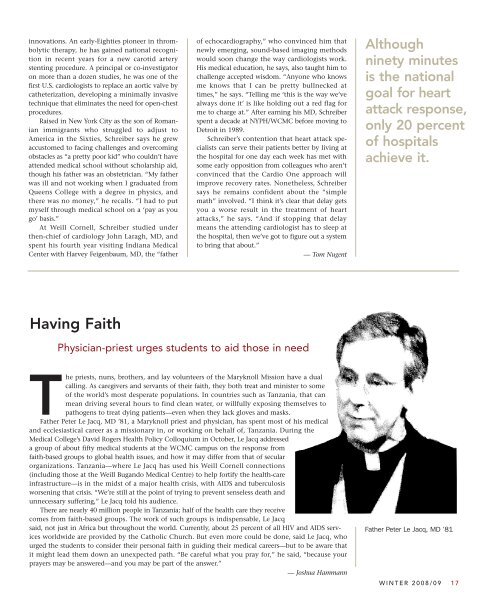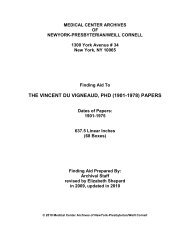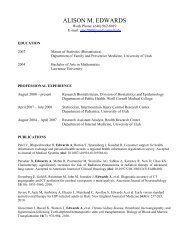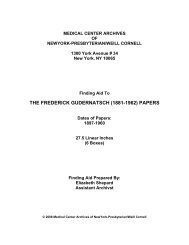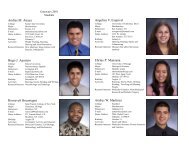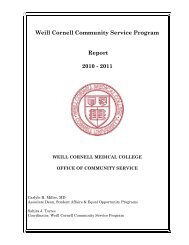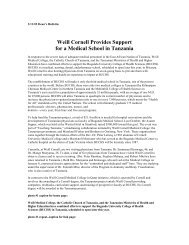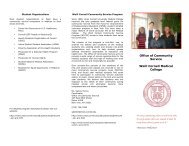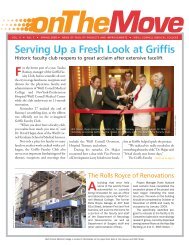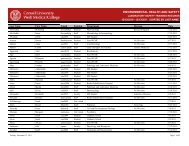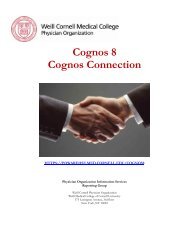Weillcornellmedicine - Weill Medical College - Cornell University
Weillcornellmedicine - Weill Medical College - Cornell University
Weillcornellmedicine - Weill Medical College - Cornell University
Create successful ePaper yourself
Turn your PDF publications into a flip-book with our unique Google optimized e-Paper software.
innovations. An early-Eighties pioneer in thrombolytic<br />
therapy, he has gained national recognition<br />
in recent years for a new carotid artery<br />
stenting procedure. A principal or co-investigator<br />
on more than a dozen studies, he was one of the<br />
first U.S. cardiologists to replace an aortic valve by<br />
catheterization, developing a minimally invasive<br />
technique that eliminates the need for open-chest<br />
procedures.<br />
Raised in New York City as the son of Romanian<br />
immigrants who struggled to adjust to<br />
America in the Sixties, Schreiber says he grew<br />
accustomed to facing challenges and overcoming<br />
obstacles as “a pretty poor kid” who couldn’t have<br />
attended medical school without scholarship aid,<br />
though his father was an obstetrician. “My father<br />
was ill and not working when I graduated from<br />
Queens <strong>College</strong> with a degree in physics, and<br />
there was no money,” he recalls. “I had to put<br />
myself through medical school on a ‘pay as you<br />
go’ basis.”<br />
At <strong>Weill</strong> <strong>Cornell</strong>, Schreiber studied under<br />
then-chief of cardiology John Laragh, MD, and<br />
spent his fourth year visiting Indiana <strong>Medical</strong><br />
Center with Harvey Feigenbaum, MD, the “father<br />
Having Faith<br />
of echocardiography,” who convinced him that<br />
newly emerging, sound-based imaging methods<br />
would soon change the way cardiologists work.<br />
His medical education, he says, also taught him to<br />
challenge accepted wisdom. “Anyone who knows<br />
me knows that I can be pretty bullnecked at<br />
times,” he says. “Telling me ‘this is the way we’ve<br />
always done it’ is like holding out a red flag for<br />
me to charge at.” After earning his MD, Schreiber<br />
spent a decade at NYPH/WCMC before moving to<br />
Detroit in 1989.<br />
Schreiber’s contention that heart attack specialists<br />
can serve their patients better by living at<br />
the hospital for one day each week has met with<br />
some early opposition from colleagues who aren’t<br />
convinced that the Cardio One approach will<br />
improve recovery rates. Nonetheless, Schreiber<br />
says he remains confident about the “simple<br />
math” involved. “I think it’s clear that delay gets<br />
you a worse result in the treatment of heart<br />
attacks,” he says. “And if stopping that delay<br />
means the attending cardiologist has to sleep at<br />
the hospital, then we’ve got to figure out a system<br />
to bring that about.”<br />
— Tom Nugent<br />
Physician-priest urges students to aid those in need<br />
The priests, nuns, brothers, and lay volunteers of the Maryknoll Mission have a dual<br />
calling. As caregivers and servants of their faith, they both treat and minister to some<br />
of the world’s most desperate populations. In countries such as Tanzania, that can<br />
mean driving several hours to find clean water, or willfully exposing themselves to<br />
pathogens to treat dying patients—even when they lack gloves and masks.<br />
Father Peter Le Jacq, MD ’81, a Maryknoll priest and physician, has spent most of his medical<br />
and ecclesiastical career as a missionary in, or working on behalf of, Tanzania. During the<br />
<strong>Medical</strong> <strong>College</strong>’s David Rogers Health Policy Colloquium in October, Le Jacq addressed<br />
a group of about fifty medical students at the WCMC campus on the response from<br />
faith-based groups to global health issues, and how it may differ from that of secular<br />
organizations. Tanzania—where Le Jacq has used his <strong>Weill</strong> <strong>Cornell</strong> connections<br />
(including those at the <strong>Weill</strong> Bugando <strong>Medical</strong> Centre) to help fortify the health-care<br />
infrastructure—is in the midst of a major health crisis, with AIDS and tuberculosis<br />
worsening that crisis. “We’re still at the point of trying to prevent senseless death and<br />
unnecessary suffering,” Le Jacq told his audience.<br />
There are nearly 40 million people in Tanzania; half of the health care they receive<br />
comes from faith-based groups. The work of such groups is indispensable, Le Jacq<br />
said, not just in Africa but throughout the world. Currently, about 25 percent of all HIV and AIDS services<br />
worldwide are provided by the Catholic Church. But even more could be done, said Le Jacq, who<br />
urged the students to consider their personal faith in guiding their medical careers—but to be aware that<br />
it might lead them down an unexpected path. “Be careful what you pray for,” he said, “because your<br />
prayers may be answered—and you may be part of the answer.”<br />
— Joshua Hammann<br />
Although<br />
ninety minutes<br />
is the national<br />
goal for heart<br />
attack response,<br />
only 20 percent<br />
of hospitals<br />
achieve it.<br />
Father Peter Le Jacq, MD ’81<br />
WINTER 2008/09 17


